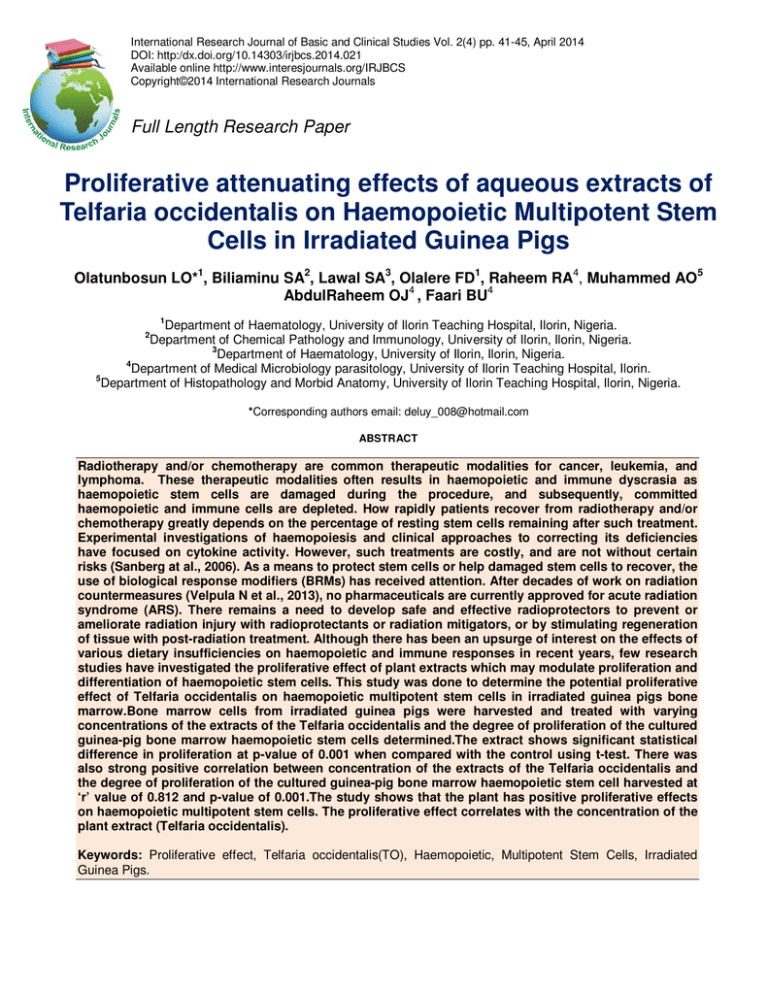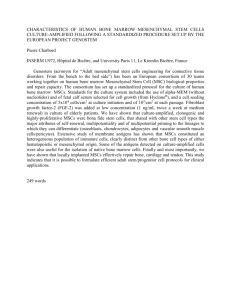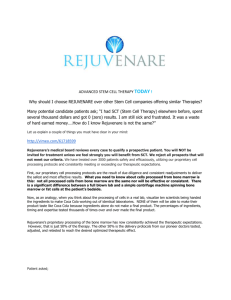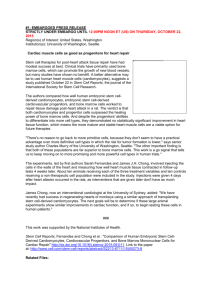Document 14092830
advertisement

International Research Journal of Basic and Clinical Studies Vol. 2(4) pp. 41-45, April 2014 DOI: http:/dx.doi.org/10.14303/irjbcs.2014.021 Available online http://www.interesjournals.org/IRJBCS Copyright©2014 International Research Journals Full Length Research Paper Proliferative attenuating effects of aqueous extracts of Telfaria occidentalis on Haemopoietic Multipotent Stem Cells in Irradiated Guinea Pigs Olatunbosun LO*1, Biliaminu SA2, Lawal SA3, Olalere FD1, Raheem RA4, Muhammed AO5 AbdulRaheem OJ4 , Faari BU4 1 Department of Haematology, University of Ilorin Teaching Hospital, Ilorin, Nigeria. Department of Chemical Pathology and Immunology, University of Ilorin, Ilorin, Nigeria. 3 Department of Haematology, University of Ilorin, Ilorin, Nigeria. 4 Department of Medical Microbiology parasitology, University of Ilorin Teaching Hospital, Ilorin. 5 Department of Histopathology and Morbid Anatomy, University of Ilorin Teaching Hospital, Ilorin, Nigeria. 2 *Corresponding authors email: deluy_008@hotmail.com ABSTRACT Radiotherapy and/or chemotherapy are common therapeutic modalities for cancer, leukemia, and lymphoma. These therapeutic modalities often results in haemopoietic and immune dyscrasia as haemopoietic stem cells are damaged during the procedure, and subsequently, committed haemopoietic and immune cells are depleted. How rapidly patients recover from radiotherapy and/or chemotherapy greatly depends on the percentage of resting stem cells remaining after such treatment. Experimental investigations of haemopoiesis and clinical approaches to correcting its deficiencies have focused on cytokine activity. However, such treatments are costly, and are not without certain risks (Sanberg at al., 2006). As a means to protect stem cells or help damaged stem cells to recover, the use of biological response modifiers (BRMs) has received attention. After decades of work on radiation countermeasures (Velpula N et al., 2013), no pharmaceuticals are currently approved for acute radiation syndrome (ARS). There remains a need to develop safe and effective radioprotectors to prevent or ameliorate radiation injury with radioprotectants or radiation mitigators, or by stimulating regeneration of tissue with post-radiation treatment. Although there has been an upsurge of interest on the effects of various dietary insufficiencies on haemopoietic and immune responses in recent years, few research studies have investigated the proliferative effect of plant extracts which may modulate proliferation and differentiation of haemopoietic stem cells. This study was done to determine the potential proliferative effect of Telfaria occidentalis on haemopoietic multipotent stem cells in irradiated guinea pigs bone marrow.Bone marrow cells from irradiated guinea pigs were harvested and treated with varying concentrations of the extracts of the Telfaria occidentalis and the degree of proliferation of the cultured guinea-pig bone marrow haemopoietic stem cells determined.The extract shows significant statistical difference in proliferation at p-value of 0.001 when compared with the control using t-test. There was also strong positive correlation between concentration of the extracts of the Telfaria occidentalis and the degree of proliferation of the cultured guinea-pig bone marrow haemopoietic stem cell harvested at ‘r’ value of 0.812 and p-value of 0.001.The study shows that the plant has positive proliferative effects on haemopoietic multipotent stem cells. The proliferative effect correlates with the concentration of the plant extract (Telfaria occidentalis). Keywords: Proliferative effect, Telfaria occidentalis(TO), Haemopoietic, Multipotent Stem Cells, Irradiated Guinea Pigs. 1 42 Int. Res. J. Basic Clin. Stud. INTRODUCTION 1990), the plant is also medicinally useful. It possesses anti-inflammatory (Oluwole, 2003), antibacterial (Odoemena, 1995), erythropoietic (Ajayi at al., 2000), anticholesterolemic (Eseyin at al., 2005a) and antidiabetic (Eseyin at al., 2000; Eseyin at al., 2005b) activities. The ripe fruit contains up to 13% oil. The leaves and the young shoots of the plant are frequently eaten as a potherb (Tindall, 1968; Okigbo, 1977; Okoli and Mgbeogu, 1983). The seeds of the plant are also popular items of diet and are cooked whole and ground up into soups. The root and leaves have been shown to contain highly toxic alkaloids and saponins (Ajayi at al.,, 2000). The leaves also contain protein, vitamins, and flavours (Tindal, 1968; Gbile, 1986). In Nigeria, the herbal preparation of the plant has been employed in the treatment of sudden attack of convulsion, malaria and anaemia (Gbile, 1986). Despite its widespread usage as food and medication information on the biological activity of the plant is very scanty. It would be of great benefit to identify certain natural compounds that can promote proliferation of haemopoietic stem cells or other stem cells individually or synergistically, such that the natural compounds could be taken in the form of a supplement that would have a significant, measurable effect (Sanberg et al., 2006). Against this background, this study was done to establish the proliferative activities of the leave extracts of Telfaria occidentalis on haemopoietic stem cell. Haemopoiesis is a process regulated by a complex network of soluble factors that stimulate the growth and differentiation of haemopoietic progenitor cells (HPC) (Metcalf, 1989). HPC have two major characteristics: selfrenewal ability and the capacity to differentiate into all lineages of haemopoietic cells (Ogawa, 1993). The proliferation and differentiation of HPC are influenced to a large extent by interactions among various cell types in the haemopoietic compartment and by haemopoietic cytokines produced by stromal cells and lymphocytes (Jacobsen, 1996). Bone marrow transplantation performed after myeloablative treatments of the recipient has been used to reconstitute haemopoiesis (Knobel at al., 1994). The use of hematopoietic cytokines together with bone marrow transplantation has been shown to hasten neutrophil and platelet recovery, suggesting that appropriate combinations of these factors may be used to promote full reconstitution of the haemopoietic compartment (Knobel at al., 1994). Haemopoietic stem cells (HSCs) have been investigated for many years for their utility in cancer treatments. Experimental investigations of haemopoiesis and clinical approaches to correcting its deficiencies have focused on cytokine activity. Cytokines modulate haemopoiesis by maintaining the self-renewal of stem cells and stimulating the proliferation and maturation of committed progenitor cells required for the continuous replacement of mature blood cells. Various combinations of cytokines including interleukin-1 (IL-1), IL-3, IL-6, stem cell factor (SCF), and erythropoietin (EPO) have been found to support the growth of multipotent progenitor cells in vitro. Individually, granulocyte-colony-stimulating factor (G-CSF) and EPO are growth factors for committed myeloid and erythroid progenitors, respectively. Clinically, G-CSF and EPO provide effective treatments for neutropenia and anaemia and are used to enhance peripheral blood progenitors as an alternative to bone marrow transplantation for cancer patients. The plant Telfaria occidentalis is commonly known as fluted pumpkin is also known as fluted gourd, Costillada (Spanish), Krobonko (Ghana), and Gonugbe (Sierra Leone). The plant belongs to the Cucurbitaceae family and is cultivated across lowland humid tropics of West Africa – Nigeria, Ghana, Sierra Leone –mainly for its nutritional value (Axtell, 1992). Telfaria occidentalis, family Cucurbitaceae (local name – Ugu), is an herbal plant found along the fringes of the closed forest in Africa. It is cultivated mostly in the West African sub-region (Burkett, 1968). The leave extract of the plant is used locally in the treatment of malaria and anaemia (Gbile, 1986). The leaves are eaten as vegetables while the seeds are either roasted or ground for other food preparations. Apart from the nutritional (Okoli et al., 1983), agricultural and industrial importance (Akoroda, MATERIALS AND METHOD Plant: Fresh sample of all the plant was obtained within Ilorin metropolis. The plant was identified by carrying out macroscopical examination on plant sample as stipulated by Dalziel (1968) and confirmed and authenticated by staff in the herbarium of Department of Plant Science, University of Ilorin, Nigeria. Telfaria occidentalis was given Serial Number 959 and Ledger Number 150. The sample was dried in an incubator at 37oC (Uniscope, USA). Plant extraction was carried out by the method of Olowosolu and Ibrahim. Plant material was macerated in pestle and mortar with 100ml distilled water at room temperature and then filtered using muslin cloth. Filtrate obtained was subsequently passed through Whatman's No. 1 Filter paper under aseptic conditions and the filtrate was collected in fresh sterilized glass tubes and used within 24h for the research work (Burkett, 1968). The final concentration of 1gm/ml was obtained as aqueous extract which served as the stock solution for dilutions needed during the course of the work. Animal Source 12 Young male guinea-pigs approximately 450g.wt obtained from the animal house, LAUTECH College of 2 Olatunbosun et al. 43 described by Caxton-Martins (Caxton-Martins, 1973) using May-Grunwald’s staining technique. Medicine Osogbo, Osun-State, Nigeria. Animals used for experiments were housed in animal house of the Department of Anatomy, University of Ilorin in a temperature and humidity-controlled room that was maintained on a 12-hour light/dark cycle. Food and water were available ad libitum throughout the experiment. Preparation of Marrow Suspension The marrow suspension was prepared from fresh autologous serum. The abdomen of the anaesthetized animal was opened up and the inferior vena-cava was exposed and incised and about 5ml of blood collected in a centrifuge tube through a glass funnel. After clotting, the blood was centrifuged for 10 min. at 3000rpm and the supernatant serum withdrawn with a Pasteur pippette into clean, small glass tubes. While the serum was being obtained, the isolated bone marrow cell was placed into the autologous serum contained in a clean glass tube fitted with a rubber stopper. This marrow suspension was used for the cytochemical studies to further establish the relative incidence of transitional cells as enumerated by Caxton-Martins (Caxton-Martins, 1973). A similar technique was used by Harris, Menkin and Yoffey. Using this technique, the incidence of damaged cells in the marrow smears was kept to a low level. Method of Irradiation of the Guinea-Pig The type, dose and method of irradiation as well as the after-care of the irradiated guinea-pigs were all based on the procedures adopted by Harris (Harris, 1967). Each guinea-pig was separately irradiated under general anesthesia (im ketamine 5mg/kg body weight plus 1mg Atropine).The animal was placed in a cotton-gauze bag and positioned lying on its side. Irradiation was given to each flank, the irradiation time being divided equally between each side, i.e. the animal was turned over onto its opposite side half-way through the procedure. Each animal was given 200r (2.0Gy) whole-body gammairradiation under general anaesthesia, using a Co60 therapy unit as source University College Hospital, Ibadan, Nigeria at a dose rate of 98.560cGy/min. May-Grunwald Staining Technique Air dry films were fixed by immersing in a jar of methanol for 20-25min. Transfer to a staining jar containing May-Grunwald’s stain freshly diluted with an equal volume of buffered water for 15min. Transfer directly without washing to a jar containing Giemsa’s stain freshly diluted with 9 volumes of buffered water, PH 6.8 for 10-15min. Transfer the slide to a jar containing buffered water PH 6.8, rapidly wash in 3-4 changes of water and finally allow to stand undisturbed in water for 25min for differentiation to take place. Stand the slide upright to dry and report using X100 objective. Report following the conventional method of reporting bone marrow smear. After-Care of the Irradiated Animals To minimize the two hazards enumerated by Harris (Harris, 1967), i.e. the danger of internal haemorrhage from minor trauma and the risk of infection, resulting from the effects of irradiation on haemopoietic tissues, each animal after irradiation was kept in a separate cage and excessive handling avoided until it was due for sacrifice. Each animal was adequately fed and given adequate supply of water. Marrow Harvest Bone marrow cells from guinea pigs were harvested by the method of Galvin et al (Galvin et al., 1996). The animals were sacrificed by cervical dislocation and the Femurs were carefully located and removed aseptically. Adherent soft tissue and cartilage were stripped from the bones and the tip of each bone was removed with a rongeur, and the marrow was harvested by inserting a syringe needle (27-gauge) into the proximal end of the bone and flushing with phosphate buffer saline into a universal bottle containing phosphate buffer saline, 200units/ml heparine, Hanks balanced salt solution (HBSS), suspended with 2% fetal calf serum (FCS). The suspended marrow cell was further diluted with the diluting factor of 1 in 20 and cell counted to achieve a cell count of 1.0 X 109/L. Culture Media Preparation Eagles MEM is mainly used. To prepare 1000ml of Growth and maintenance Eagles MEM media, the procedures involved include:1 bottle of Eagles MEM powder containing 9.4g was dissolved completely in 1000ml sterile double distilled deionized water. This was autoclaved at 121oC for 15 minutes with cap slightly loose and allow to cool to room temperature. The pH of the autoclaved Eagles MEM was ensured to be between (4.3 – 4.5) Label 2 empty sterile 500ml bottles indicating growth or maintenance medium, the date the medium is prepared and the expiration date, batch number as well as the initials of the personnel who prepares it. The reagents below were dispensed into the empty sterile 500ml bottles respectively. Microscopic Observation of Harvested Bone Marrow Harris16 has given a report of the haemopoietic events occurring in guinea-pig bone-marrow following sub-lethal whole body gamma irradiation at 13days after irradiation. This stage was described by Harris ((Harris, 1967) as the initial phase of final haematopoietic recovery which was further confirmed by cytochemical reactivities as 3 44 Int. Res. J. Basic Clin. Stud. Table 1. Culture Media Preparation Protocol REAGENTS 7.5% Sodium bicarbonate L-Glutamine HEPES IM Penicillin Streptomycin FBS GM (ml) 7.5 5 5 5 50 MM (ml) 12.5 5 5 5 10 Table 2. A comparison of means of proliferative effects of Telfaria occidentalis and Control PLANTS EXTRACTS Telfaria occidentalis (TO) CONCENTRATION VARIATION(100% -0.313) MEAN±STD DEV. OF PROLIFERATION 24 2.96±0.93 t-test p-value=0.001 CONTROL WELLS WITHOUT EXTRACT SHOWED PROLIFERATIVE VALUE OF 0.93 Table 3. Correlation between concentrations of the extracts of the Telfaria occidentalis and degree of proliferation. Parameters Mean±sd Calculated ‘r’ P-value Telfaria occidentalis 2.9470±0.94 0.835 . 001 plates were then incubated in a CO2 incubator for 5hr and the culture media removed with needle and syringe. 200µl of DMSO was added to each well with pipetting up and down to dissolve crystals. Plates were re-incubated in a CO2 incubator for 5 minutes, transferred to microplate reader and the absorbance measured at 550nM (S). The autoclaved Eagles MEM was added to each of the 500ml bottles containing the reagents above to reach the mark of 500ml on the bottle. The pH was ensured to be between (7.2 – 7.4) An aliquot of each prepared bottle of medium was added to tissue culture tubes and label appropriately for sterility testing. The aliquot the aliquot was incubated at 36oC for 5 – 7 days, inoculate into Thioglycollate broth. The prepared media was stored at +4oC. The prepared media was aliquoted into 250ml sterile bottles after the sterility testing result is out21. RESULTS AND DISCUSSION In spite of significant advances over the past decades in the treatment of radiation induced haemopoietic syndrome, this condition remains a significant clinical problem in patients receiving radiotherapy and chemotherapy. This study investigates the potential proliferative effects of the Telfaria occidentalis on haemopoietic multipotent stem cells. The study demonstrates induction of proliferation of stem and progenitor cells by using plant’s extract at a wide range of concentrations. The results obtained from the study shows that there was a significant statistical difference in proliferation of the stem cells with mean value of 2.96±0.93for the test and 0.93±0.01for the control at p-value of 0.001(Table 2). There was also strong positive correlation between the concentration of the extracts and the degree of proliferation of the haemopoietic stem cells at ‘r’ value of 0.835 and p-value of 0.001(Table 3). In other words, the degree of proliferation is directly proportional to the concentration of the extracts. This finding was similar to the one reported by Sanberg et al (Sanberg et al., 2006) on certain whole food extracts that were found to Cell Culture Technique At 13th day Post irradiation the bone marrow cells were harvested and cultured with the extract of the plant at concentration ranges of 0.313-100%. 5µl of suspended guinea-pig bone marrow cells harvested were cultured in 9 a Lamina Flow Cabinet at a concentration of 1.0 X 10 /L in 20µl of Growth Eagles Minimum Essential Media (MEM) and 10µl of the plant extract of Telfaria occidentalis was added to enhance proliferation. Another set of 24 Wells were also set alongside with the test to serve as control in which no extract was added to enhance the proliferation. The culture plates (48 wells) o were incubated at 37 C for 72 hours. After the treatment, the cells were prepared for 3-[4,5-Dimethylthiazol-2-YL]2,5-Diphenyltetrazolium Bromide (MTT) analysis of cell proliferation. Cell Proliferation Assay 20µl of MTT Solution were added to each well 5 hours before the end of the treatment in the culture plate. The 4 Olatunbosun et al. 45 increase cell proliferation of human bone marrow cells in a dose dependent manner. Available evidence indicates that qualitative changes in haemopoietic stem cells and progenitors, such as the decision of stem cells to self-renew or differentiate, or selection of lineage potentials by the multi-potential progenitors during differentiation (commitment), are intrinsic properties of the progenitors and are stochastic in nature. In-contrast, proliferative kinetics of the progenitors, namely survival and expansion of the progenitors, appear to be controlled by a number of interacting cytokines. While proliferation and maturation of committed progenitors is controlled by late-acting lineage-specific factors such as Ep, M-CSF, G-CSF, and IL-5, progenitors at earlier stages of development are controlled by a group of several overlapping cytokines. IL-3, GM-CSF, and IL-4 regulate proliferation of multipotential progenitors only after they exit from G0 and begin active cell proliferation. Triggering of cycling by dormant primitive progenitors and maintenance of B-cell potential of the primitive progenitors appears to require interactions of early acting cytokines including IL-6, GCSF, IL-11, IL-12, LIF, and SF. Previous studies from our group have shown that some plant extracts are useful biological response modifiers that protect stem cells or help damaged stem cells to recover during acute radiation syndrome. Radiation exerts an antiangiogenic effect on tumors, inhibiting endothelial proliferation and survival in the tumor microvasculature. The results of the study confirms that administration of the extracts of the plant at the doses considered may cause or induce proliferation of haemopoietic multipotent stem cells at even the lowest dose and increases as concentration increases. This finding provides a scientific foundation for the investigation of Telfaria occidentalis in clinical trials as a potential antianemic agent for the proliferation of haemopoietic stem cell. The active components involved and the mechanism of action would require further elucidation. Ogawa M (1993). Differentiation and Proliferation of Hematopoietic Stem Cells. Blood 81(11), 2844-2853. Jacobsen SEW (1996). IL-12, A direct stimulator and indirect inhibitor of haematopoiesis. In: Immunoregulation by IL-12, 62nd Forum in Immunology. Pp506-510. Knobel KM, McNally MA, Berson AE et al. (1994). Long-term reconstitution of mice after ex vivo expansion of bone marrow cells. Differential activity of cultured bone marrow and enriched stem cell populations. Exp Hematol 22:1227-1235. Sanberg C, Davis SD, Bickford P, Shytle P, Donglas R (2006). Combined effects of nutrients on proliferation of stem cells. U.S Patent Number 20060275512. OR Sanberg P, Davis S (2006). Combined effects of nutrients on proliferation of stem cells. United States Patent 7442394. Olowosulu AK, Ibrahim YKE (2006). Studies on the antimicrobial screening of Aqueous extracts of five plants used in Folk medicine in Nigeria. West Afr. J Biol. Sc. 3(5): 21-26. Harris PF (1967). (M.D. Thesis). Univ. of Bristol. Galvin RJS, Bryan P Horn JW, Rippy MK, Thomas JE (1996). Development and characterization of a porcine model to study osteoclast differentiation and activity. Bone 19, (in press) Miroslav H, Jiřina V, Zuzana Š, Jaroslav M, Stanislav F (2008). Haemopoietic recovery after transplantation cd117+b220– (lacz+) bone marrow cells in lethally irradiated mice. Acta Medica. 51(1):37–41. Caxton-Martins EA (1973). Some Histochemical Studies on Transitional Cells in Normal and Irradiated Guinea-pig Bone Marrow, and in the Bone Marrow of the Human Foetus (M.Phil. Thesis) University of Nottingham. Burkett HM (1968). The results of plants of West Africa. Royal Botanic Garden Kews, England. Vol. 1 pp. 603-604 Gbile ZO (1986). Ethnobotany, Taxonomy and Conservation of Medicinal plant. In the state of medicinal plant research in Nigeria. Pp. 19 Okoli BE, Mgbeogu CM (1983). Fluted Pumpkin , Telfairia Occidentalis: West African Vegetable Crop. Economic Botany, 37 (2); pp145149. Akoroda MO (1990): Ethnobotany of Telfairia Occidentalis (Cucurbitaceae) among Igbos of Nigeria. Economic Botany 44(1), 29-39. Oluwole FS, Falade AO, Ogundipe OO (2003). Anti-inflammatory effect of some common Nigeria vegetables. Nig. J. Physiol. Sci. 18(12):35-38 Odoemena CS, Essien JP (1995). Antibacterial activity of the root extract of T. Occidentalis .West Afr. J.Biol.and Appl. Chem.40:1-4 Ajayi OI, Ajayi TC, Omokaro ED, Halim NKD (2000). Erythropoietic value of T. Occidentalis in rabbit. A preliminary study. Nig. J. Physiol. Sci. 16 (1-2): 1-3. Eseyin OA, Igboasoiyi AC, Oforah E, Ching P, Okoli BC (2005a) Effect of extract of T. Occidentalis leaves on some biochemical parameters in rat. Glob. J. Pure App. Sci. 11(1):85-87 Eseyin OA, Oforah E, Dooka BD (2000) Preliminary study of the hypoglycemic action of the extract of leaf of T. Occidentalis in normoglycemic guinea pigs. Global. 6(4):639-641 Eseyin OA, Igboasoiyi AC, Oforah E, Nkop, Agboke A (2005b) Hypoglycemic activity of T. Occidentalis in rats. J. Pharm. and Bioresources. 2(1):36-42 Tindal HD (1968). Commercial vegetable growing Oxford Press. London. Pp69. Okigbo BN (1977). Neglected plants of horticultural and nutritional importance in traditional farming systems of Tropical Africa. Acta. Okoli BE, Mgbeogu CM (1983). Fluted pumpkin (Telfaria occidentalis). West Africa Veg. Crop. Eco.Botany. 37 (2): 145-149. Yoffey JM (1956). “The mobilization and turnover times of cell populations in blood and blood-forming tissue”. J. Histochem. Cytochem. 4: 516-530. Nagalaxmi Velpula, Sridevi Ugrappa, Srikanth Kodangal (2013). A role of radio protective agents in cancer therapeutics: a review. Int. J. Basic Clin. Pharmacol. 2(6):677-682. CONCLUSION The study confirms the usefulness of the extract of the Telfaria occidentalis in restoring normal haemopoiesis as an alternative to both bone marrow transplantation and administration of cytokines for cancer patients, immunesuppressed patients and other haemopoietic syndromes as a consequence of disease, radiation, chemotherapy and stress. REFERENCES Metcalf D (1989). The Molecular Control of Blood Cells. Harvard University Press: Cambridge. 5



